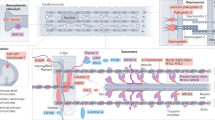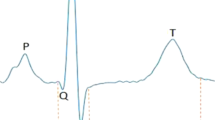Abstract
Human cardiac disease is the result of complex interactions between genetic susceptibility and environmental stress. The challenge is to identify modifiers of disease, and to design new therapeutic strategies to interrupt the underlying disease pathways. The availability of genomic databases for many species is uncovering networks of conserved cardiac-specific genes within given physiological pathways. A new classification of human cardiac diseases can be envisaged based on the disruption of integrated genomic circuits that control heart morphogenesis, myocyte survival, biomechanical stress responses, cardiac contractility and electrical conduction.
This is a preview of subscription content, access via your institution
Access options
Subscribe to this journal
Receive 51 print issues and online access
$199.00 per year
only $3.90 per issue
Buy this article
- Purchase on Springer Link
- Instant access to full article PDF
Prices may be subject to local taxes which are calculated during checkout




Similar content being viewed by others
References
Benson, D. W. et al. Mutations in the cardiac transcription factor NKX2.5 affect diverse cardiac developmental pathways. J. Clin. Invest. 104, 1567–1573 (1999).
Gruber, P. J. et al. RXRα deficiency confers genetic susceptibility for aortic sac, conotruncal, atrioventricular cushion, and ventricular muscle defects in mice. J. Clin. Invest. 98, 1332– 1343 (1996).
Mark, M. et al. A genetic dissection of the retinoid signalling pathway in the mouse. Proc. Nutr. Soc. 58, 609– 613 (1999).
Fleming, A. & Copp, A. J. Embryonic folate metabolism and mouse neural tube defects. Science 280, 2107–2109 (1998).
Kreldberg, J. A. et al. WT-1 is required for early kidney development. Cell 74, 679–691 ( 1993).
Chen, J., Kubalak, S. W. & Chien, K. R. Ventricular muscle restricted gene targeting of the RXRα gene reveals a non-cell autonomous requirement in cardiac chamber morphogenesis. Development 125, 1943– 1949 (1998).
Grossfeld, P. D., Rothman, A., Gruber, P. & Chien, K. R. in Molecular Basis of Cardiovascular Disease: A Companion Text to E. Braunwald's Heart Disease (ed. Chien, K. R.) 135–165 (Saunders, Cambridge, MA, 1999).
Galili, N. et al. A region of mouse chromosome 16 is syntenic to the DiGeorge, velocardiofacial syndrome minimal critical region. Genome Res. 7, 17–26 (1997 ).
Yamagishi, H., Garg, V., Matsuoka, R., Thomas, T. & Srivastava, D. A molecular pathway revealing a genetic basis for human cardiac and craniofacial defects. Science 283, 1158–1161 (1999).
Lindsay, E. A. et al. Congenital heart disease in mice deficient for the DiGeorge syndrome region. Nature 401, 379– 383 (1999).
Yanagisawa, H. et al. Role of endothelin-1/endothelin-A receptor-mediated signaling pathway in aortic arch patterning in mice. J. Clin. Invest. 102, 22–33 (1998).
Waldo, K. et al. A novel role for cardiac neural crest in heart development. J. Clin. Invest. 103, 1499–1507 (1999).
Hunter, J. J. & Chien, K. R. Signaling pathways for cardiac hypertrophy and failure. N. Engl. J. Med. 341, 1276–1283 (1999).
Chien, K. R. Stress pathways and heart failure. Cell 98, 555–558 (1999).
Sheng, Z., Pennica, D., Wood, W. I. & Chien, K. R. Cardiotrophin-1 displays early expression in the murine heart tube and promotes cardiac myocyte survival. Development 122, 419– 428 (1996).
Hirota, H. et al. Loss of a gp130 cardiac muscle cell survival pathway is a critical event in the onset of heart failure during biomechanical stress. Cell 97, 189–198 ( 1999).
Zhao, Y. Y. et al. Neuregulins promote survival and growth of cardiac myocytes. Persistence of ErbB2 and ErbB4 expression in neonatal and adult ventricular myocytes. J. Biol. Chem. 273, 10261– 10269 (1998).
Meyer, D. & Birchmeier, C. Multiple essential functions of neuregulin in development. Nature 378, 386–390 (1995).
Slamon, D. et al. Addition of Herceptin (humanized anti-Her2 antibody) to first line chemotherapy for Her2 overexpressing medistatic breast cancer (Her2 + \ MBC) markedly increases anti-cancer activity; a randomized, multinational controlled phase III trial. Proc. Am. Soc. Clin. Oncol. 17, 98a (1998).
Sadoshima, J. & Izumo, S. The cellular and molecular response of cardiac myocytes to mechanical stress. Annu. Rev. Physiol. 59, 551–571 (1997).
Chen, J. & Chien, K. R. Complexity in simplicity: monogenic disorders and complex cardiomyopathies. J. Clin. Invest. 103, 1483–1485 (1999).
Arber, S. et al. MLP-deficient mice exhibit a disruption of cardiac myofibrillar organization, dilated cardiomyopathy, and heart failure. Cell 88, 393–403 (1997).
Olson, T. M., Michels, V. V., Thibodeau, S. N., Tai, Y. S. & Keating, M. T. Actin mutations in dilated cardiomyopathy, a heritable form of heart failure. Science 280, 750–752 (1998).
Dalakas, M. C. et al. Desmin myopathy, a skeletal myopathy with cardiomyopathy caused by mutations in the desmin gene. N. Engl. J. Med. 342 , 770–780 (2000).
Satoh, M. et al. Structural analysis of the titin gene in hypertrophic cardiomyopathy: identification of a novel disease gene. Biochem. Biophys. Res. Commun. 262, 411–417 ( 1999).
McCoy, G. et al. Identification of a deletion in plakoglobin in arrhythmogenic right ventricular cardiomyopathy with palmoplantar keratoderma and woolly hair (Naxos disease). Lancet 355, 2119– 2124 (2000).
Dinoviâc-Carugo, K., Young, P., Gautel, M. & Saraste, M. Structure of the alpha-actinin rod: molecular basis for cross-linking of actin filaments. Cell 98, 537–546 ( 1999).
Coral-Vazquez, R. et al. Disruption of the sarcoglycan-sarcospan complex in vascular smooth muscle: a novel mechanism for cardiomyopathy and muscular dystrophy . Cell 98, 465–474 (1999).
Bonne, G. et al. Mutations in the gene encoding lamin A/C cause autosomal dominant Emery-Dreifuss muscular dystrophy. Nature Genet. 21 , 285–288 (1999).
Tada, M. & Toyofuku, T. Molecular regulation of phospholamban function and expression. Trends Cardiovasc. Med. 8, 330–340 (1998).
Chien, K. R. Genes and physiology: molecular physiology in genetically engineered animals . J. Clin. Invest. 97, 901– 909 (1996).
Minamisawa, S. et al. Chronic phospholamban–sarcoplasmic reticulum calcium ATPase interaction is the critical calcium cycling defect in dilated cardiomyopathy . Cell 99, 313–322 (1999).
Miyamoto, M. E. et al. Adenoviral gene transfer of SERCA2a improves left ventricular function in aortic-banded rats in transition to heart failure. Proc. Natl Acad. Sci. USA 97, 793– 798 (2000).
Marx, S. O. et al. PKA phosphorylation dissociates FKBP12.6 from the calcium release channel (ryanodine receptor): defective regulation in failing hearts . Cell 101, 365–376 (2000).
Curran, M. E., Sanguinetti, M. C. & Keating, M. T. in Molecular Basis of Cardiovascular Disease: A Companion Text to E. Braunwald's Heart Disease (ed. Chien, K. R.) 302– 311 (Saunders, Cambridge, MA, 1999).
Gourdie, R. G., Kubalak, S. & Mikawa, T. Conducting the embryonic heart: orchestrating development of specialized cardiac tissues. Trends Cardiovasc. Med. 9, 18–26 (1999).
Zhu, H. et al. A novel, tissue restricted zinc finger protein (HF-1b) binds to the cardiac regulatory element (HF-1b/MEF-2) in the rat myosin light chain-2 gene. Mol. Cell Biol. 13, 4432– 4444 (1993).
Nguyen-Tran, V. T. B. et al. A novel genetic pathway for cardiac sudden death via defects in the transition between ventricular and conduction system cell lineages . Cell 102, 671–682 (2000).
Schott, J. J. et al. Congenital heart disease caused by mutations in the transcription factor NKX2-5. Science 281, 108– 111 (1998).
Franz, T. Persistent truncus arteriosus in the Splotch mutant mouse. Anat. Embryol. 180, 457–464 ( 1989).
Clouthier, D. E. et al. Cranial and cardiac neural crest defects in endothelin-A receptor-deficient mice. Development 125, 813– 824 (1998).
Kurihara, Y. et al. Elevated blood pressure and craniofacial abnormalities in mice deficient in endothelin-1. Nature 368, 703–710 (1994).
Yanagisawa, H. et al. Dual genetic pathways of endothelin-mediated intercellular signaling revealed by targeted disruption of endothelin converting enzyme-1 gene. Development 125, 825– 836 (1998).
Ya, J. et al. Sox4-deficiency syndrome in mice is an animal model for common trunk. Circ. Res. 83, 986– 994 (1998).
Reaume, A. G. et al. Cardiac malformation in neonatal mice lacking connexin 43 . Science 267, 1831–1834 (1995).
Donovan, M. J., Hahn, R., Tessarollo, L. & Hempstead, B. L. Identification of an essential nonneuronal function of neurotrophin 3 in mammalian cardiac development. Nature Genet. 14, 210– 213 (1996).
Tessarollo, L. et al. Targeted deletion of all isoforms of the trkC gene suggests the use of alternate receptors by its ligand neurotrophin-3 in neuronal development and implicates trkC in normal cardiogenesis. Proc. Natl Acad. Sci. USA 94, 14776–14781 ( 1997).
Brannan, C. I. et al. Targeted disruption of the neurofibromatosis type-1 gene leads to developmental abnormalities in heart and various neural crest-derived tissues . Genes Dev. 8, 1019–1029 (1994).
Tullio, A. N. et al. Nonmuscle myosin II-B is required for normal development of the mouse heart. Proc. Natl Acad. Sci. USA 94, 12407–12412 (1997).
Sanford, L. P. et al. TGFβ2 knockout mice have multiple developmental defects that are nonoverlapping with other TGFβ knockout phenotypes. Development 124, 2659–2670 (1997).
Srivastawa, D. et al. Regulation of cardiac mesodermal and neural crest development by the bHLH transcription factor, dHAND. Nature Genet. 16, 154–160 (1997).
Iida, K. et al. Essential roles of the winged helix transcription factor MFH-1 in aortic arch patterning and skeletogenesis. Development 124, 4627–4638 (1997).
Takihara, Y. et al. Targeted disruption of the mouse homologue of the Drosophila polyhomeotic gene leads to altered anteroposterior patterning and neural crest defects. Development 124, 3673– 3682 (1997).
Emanuel, B. S., Budarf, M. L. & Scambler, P. J. in Heart Development (eds Harvey, R. P. & Rosenthal, N.) 463–478 (Academic, San Diego, 1999).
Acknowledgements
I thank T. Nakamura, M. Hoshijima and S. Minamisawa for assistance with the figures, and J. Chen, S. Evans and K. Knowlton for helpful discussions. The author's laboratory is supported by grants from NIH, the Jean LeDucq Foundation, and an Endowed Chair from the American Heart Association (California Affiliate).
Author information
Authors and Affiliations
Corresponding author
Rights and permissions
About this article
Cite this article
Chien, K. Genomic circuits and the integrative biology of cardiac diseases. Nature 407, 227–232 (2000). https://doi.org/10.1038/35025196
Issue Date:
DOI: https://doi.org/10.1038/35025196
This article is cited by
-
Promise of adeno-associated virus as a gene therapy vector for cardiovascular diseases
Heart Failure Reviews (2017)
-
Arrhythmogenic right ventricular cardiomyopathy secondary to adipose infiltration as a cause of episodic collapse in a horse
Irish Veterinary Journal (2015)
-
Humid heat exposure induced oxidative stress and apoptosis in cardiomyocytes through the angiotensin II signaling pathway
Heart and Vessels (2015)
-
RNA-sequencing analysis reveals new alterations in cardiomyocyte cytoskeletal genes in patients with heart failure
Laboratory Investigation (2014)
-
Soluble epoxide hydrolase is a susceptibility factor for heart failure in a rat model of human disease
Nature Genetics (2008)
Comments
By submitting a comment you agree to abide by our Terms and Community Guidelines. If you find something abusive or that does not comply with our terms or guidelines please flag it as inappropriate.



